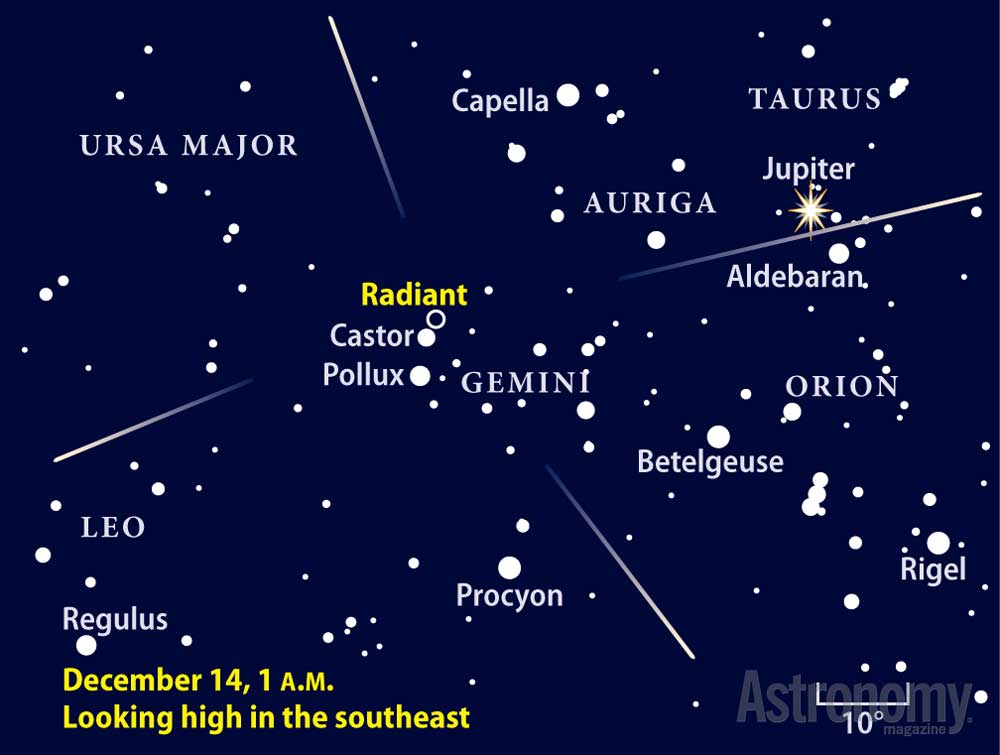Key Takeaways:
One of 2014’s best meteor showers makes its appearance in early May. The Eta Aquariid shower peaks the morning of May 6, although the number of “shooting stars” should be nearly as high a morning or two before and after. Observers under a dark sky can expect to see up to 40 meteors per hour at the Eta Aquariids’ peak.
And conditions should be ideal this year. According to Astronomy magazine Senior Editor Michael Bakich, “The waxing crescent Moon sets shortly after 1 a.m. local daylight time, leaving the prime observing hours close to dawn Moon-free.” For the best views, find an observing site far removed from city lights. Observers need no special equipment — the eyes alone work best because they provide the largest possible field of view. Sit in a reclining lawn chair to keep comfortable, and bring along a blanket to ward off the chill.
The meteors appear to radiate from a spot in the constellation Aquarius. For those who live near 40° north latitude, this radiant rises in the east around 2:30 a.m. local daylight time and climbs nearly 20° high by 4 a.m. Morning twilight begins to interfere soon thereafter, so the best views should come between 3 and 4 a.m. The radiant climbs much higher before dawn for observers closer to the equator or in the Southern Hemisphere, where the shower often produces 70 meteors per hour. Eta Aquariid meteors tend to have long paths and many leave glowing trails that can last for several seconds.
These meteors began life as tiny specks of dust ejected by Comet 1P/Halley during its innumerable trips around the Sun. Over the eons, these particles spread out along the comet’s orbit. Every May, Earth runs through this stream of dust. The particles hit Earth’s atmosphere at 148,000 mph (238,000 km/h), vaporizing from friction with the air and leaving behind the streaks of light we call meteors. The dust particles burn up high in the atmosphere, typically above an altitude of 50 miles (85 kilometers). None of the particles in any meteor shower is big enough to survive its trip through our atmosphere and reach the ground.
Fast facts:
- At 148,000 mph (238,000 km/h), Eta Aquariid meteors are the second-fastest of any annual shower. Only the Leonids of November hit our atmosphere faster, at 159,000 mph (256,000 km/h).
- The Eta Aquariid meteor shower is one of two that derives from Comet 1P/Halley’s debris. The other is the Orionid shower, which peaks in October.
- Although most shower meteors meet their demise in Earth’s atmosphere at altitudes between 50 and 70 miles (85 and 115 kilometers), a few bigger particles survive to within 12 miles (20km) of the surface. These typically produce “fireballs” that glow as bright as or brighter than Venus.
- Video: How to observe meteor showers, with Michael E. Bakich, senior editor
- Video: Easy-to-find Objects in the 2014 Spring Sky, with Richard Talcott, senior editor
- StarDome: Locate the shower’s radiant in Aquarius in your night sky with our interactive star chart.
- The Sky this Week: Get your Eta Aquariid meteor shower info from a daily digest of celestial events coming soon to a sky near you.
- Sign up for our free weekly email newsletter.











